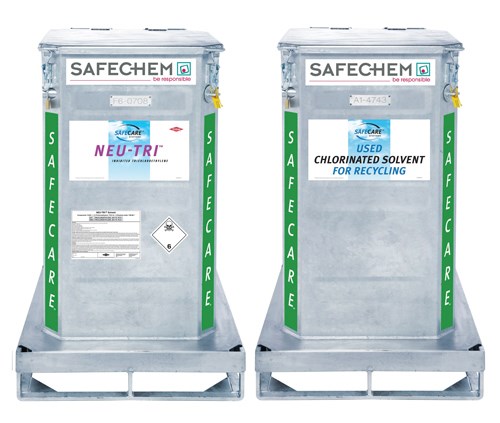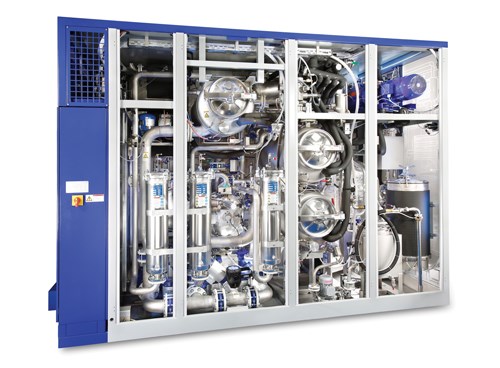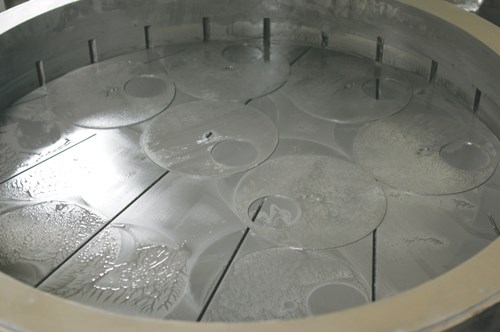Closing the Gap in Critical Cleaning Challenges
Solvents may be the answer to a shop’s need for efficient, reliable and sustainable cleaning of precision machined parts.
Many applications require a precision cleaning process to ensure that machined metal parts fulfill high cleanliness demands. When metal chips and non-polar residues such as oils, greases and cooling lubricants must be removed, a solvent is often the best choice. If used in a vacuum sealed cleaning machine, the solvent offers reliable and cost-effective cleaning that also satisfies regulatory guidelines.
Machined metallic parts inevitably get dirty during the manufacturing process, and in many industries, requirements for parts cleanliness are becoming tighter. Choosing the appropriate cleaning process can be challenging. The cleaning agent’s capacity to dissolve contaminants affects quality, costs and the stability of the cleaning process.
Solvent-Based Cleaning
In selecting the right cleaning medium, the “like dissolves like” principle of chemistry applies. In other words, for removing mineral oil-based (non-polar) contaminants such as machining oils, greases, waxes, corrosion inhibitors, or esters, a solvent is typically the preferred cleaning agent. As it washes away the oil, chips and particles present on the part surface, contaminants lose adhesion and can be removed mechanically—by ultrasonic cleaning, injection flood washing, or other means.
Solvents commonly used for machining processes include chlorinated hydrocarbons (CHC)—perchloroethylene, trichloroethylene and methylene chloride—as well as non-halogenated hydrocarbons (HC) and modified alcohols.
Non-flammable chlorinated hydrocarbons such as the perchloroethylene and trichloroethylene (sold by Safechem North America as Dowper SVG Double Stabilized and Neutri solvent, respectively) are chemically stable. They have minimal surface tension and offer good recycling potential. These solvents allow for effective removal of non-polar oils and grease, even from components with complex shapes, without corrosion, oxidation, discoloration, and burning, dulling or other surface impairments.
Hydrocarbons and modified alcohols are distinguished by their chemical compositions. The modified alcohol Dowclene 1601 from Safechem provides both hydrophilic and lipophilic portions in the structure and offers exceptional solvency for a range of soils and contaminants. This feature enables the agent to effectively isolate contaminants and remove them from surfaces without re-depositing them, so the parts dry without residue. This modified alcohol is also suitable for difficult applications such as cleaning lapped parts, sintered metals and high quality, high precision small parts.
Solvent Cleaning Equipment
Historically, from an environmental and worker safety viewpoint, solvents for industrial parts cleaning have gained a bad reputation. For decades, the solvents were used in open, unsealed cleaning equipment and were often improperly handled and disposed of. Such open systems not only lead to high solvent consumption and wasted costs, but many solvents also generate emissions that are harmful to workers and the environment.
Instead, for safer and more environmentally friendly processes, solvents can be used in fully closed, single-chamber cleaning systems with integrated distillation units for solvent reclamation. Solvent cleaning systems from Dürr Ecoclean offer an integrated distillation unit, full-flow and bypass filtration, injection flood washing (IFW), heat recovery, and several energy saving and emission reducing features as standard. Dürr machines can be adapted to specific cleanliness, throughput, part geometry and preservation requirements via appropriate dimensioning, process engineering, fluid treatment and drying technology. Operating under full vacuum, these cleaning machines eliminate the need for additional explosion protection for combustible solvents (HCs and modified alcohols). Additionally, they are equipped with redundant safety technology.
A high vacuum performance in combination with strong pumps and large-diameter piping ensure maximum throughput cleaning efficiency and fast drying even for very complex part geometries. Applications calling for oil-free surfaces in downstream steps such as hardening, CVD/PVD coating, brazing, welding or adhesive bonding often impose the need for ultra-fine cleaning. To this end, closed solvent cleaning systems can be equipped with several solvent tanks for a multi-stage cleaning process. An electropolished work chamber and optimized flow conditions ensure that no foreign matter remains present in the system where it might re-contaminate previously cleaned parts.
For continuous solvent reconditioning, Dürr systems come with an integrated, fully automatic distillation unit as well as full-flow and bypass filtration in the standard package. The standard distillation module provides a consistently good degreasing performance even at oil intake rates of up to 5 liters/hour. For high oil loads or ultra-fine cleaning, an optional oil discharge unit is available for integration into the equipment.
Reducing Emissions and Solvent Consumption
In combination with fully closed, single-chamber cleaning systems, the Safecare closed-loop transfer system developed by Safechem enables an emission-free cleaning process. This delivery and handling system for solvents consists of two separate, specially designed containers—one for fresh and one for used solvent. Each container is delivered with a standard drum inside. The steel container protects the drum, preventing damage or spills. The containers are easy to handle and store and allow the safe management of solvents on site.
During the solvent transfer to the cleaning machine, a special leak-free, dry-break coupling prevents spills and vapor emissions. When transferring used solvent from the cleaning machine to the Safecare container, a dry-break coupling adapter and a vapor return connection prevent emissions. This design safeguards the operator and environment from potential contact with the solvent.
In addition to the Safecare system, Safechem offers efficient solutions to monitor and maintain the quality of solvents. As dirty parts bring emulsions into the cleaning bath, the acid content of the solvent can increase. Linked to this is the risk of corrosion occurring on part surfaces and inside the cleaning machine. Maxicheck test kits enable the operator to quickly check the solvent’s alkaline level and acid acceptance. If necessary, Maxistab stabilizer or Maxiboost additive for solvents can be added to maintain stabilizer concentrations at the optimum level. Proper concentration ensures not only maximum cleaning quality, but it also helps to protect the cleaning machine and minimize solvent consumption by extending the solvent’s lifespan.
Related Content
Kyzen Solvents Provide Safe Parts Cleaning
The SLV901 and SLV803 solvents are formulated to maintain cleaning efficacy while providing a safe, environmentally friendly alternative to processes that use PFAS and HFCs.
Read More3 Common Filtration Questions Answered
Learn about the variety of filters for removing particulates from a cleaning fluid, how to determine cleaning fluid life and more.
Read MoreIndustrial Cleaning Shop Zeros In on Precision
This parts cleaning company is elevating its efforts to become a technical cleanliness expert, which presents an exciting, yet sometimes arduous, journey. The ongoing education of the team as well as significant investments in equipment and processes attribute to this shop’s success.
Read MoreMeeting Stringent Cleaning Goals With Modular Ultrasonic System
A knee implant manufacturer implements an advanced cleaning system that meets its tight cleaning requirements, including documenting, validating and tracing the entire cleaning process.
Read MoreRead Next
Power in Compact Cleaning
Capital improvement decisions can often be “no risk/no reward.” This shop passed on potential production equipment in favor of a new cleaning system and found great reward.
Read More5 Aspects of PMTS I Appreciate
The three-day edition of the 2025 Precision Machining Technology Show kicks off at the start of April. I’ll be there, and here are some reasons why.
Read MoreEmerging Leaders Nominations Now Open
Here’s your chance to highlight a young person in your manufacturing business who is on the path to be a future leader moving your company forward.
Read More

























